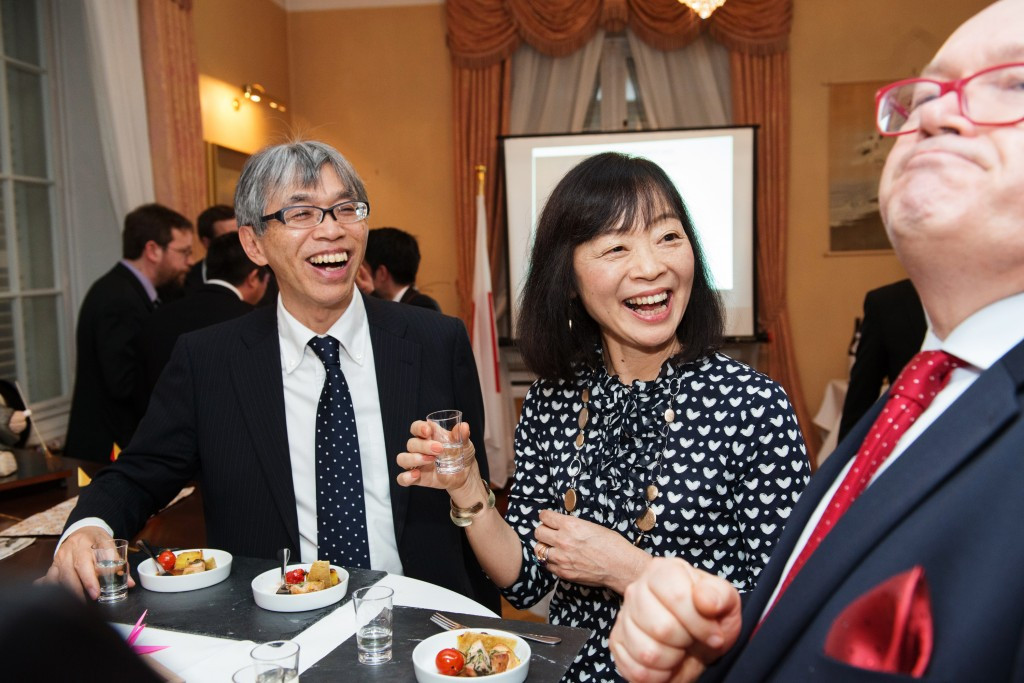A few selected guests gathered on 23 March at the residence of the Japanese ambassador to hear a presentation of Jean-Paul Choi, vice world champion saké sommelier and owner of the restaurant Origami in Belval.
Introducing saké
Choi explained that saké is a general term for alcohol beverages in Japan, and that the rice wine Europeans consider to be saké is called nihonshu. Saké is made everywhere in Japan, though not as frequently in the South. Saké is fermented, just like wine and beer. The rice can be “polished” to varying degrees; the more polished, the lighter it is. The deeper the sake, the more robust its flavour. Saké can be pasteurised, filtered or diluted--the methods are varied and the results differ widely in terms of flavour and colour.
Choi explained that various glasses can be used to serve sake, but they should always be small--the Japanese custom considers it good manners to fill up the small glasses frequently to be the perfect host. This event certainly lived up to the famous reputation of Japanese hospitality, as ambassador Suzuki surprised everyone with a grand buffet of traditional Japanese food after the tasting.
An excellent tasting session
A selection of eight sorts of saké was paired with European dishes.
The aperitif of warm sake was served in a masu (a rectangular wooden box cup which flavoured the saké as well).
The first dish was a goat’s cheese concoction which was served with two different saké. The first, Hamatomoe, was very clean, from the Senkin Shuzo 1806 brewery and was not filtered. The second, Senkin no Kimoto, was a bit darker, and had a rich, sweet and sour flavour.
The tender chicken breast was served with a beer sauce and was accompanied by 'Chōchōkyū Yuzu, a sake from the region of Wakayama which had an aniseed and dried fruit character with a sweet and smooth texture. The two complemented each other remarkably well.
The big favourite was, however, the Senkin Tsurukame, a 19% polished wine from the brewery Senkin Shuzo. It was unpasteurised, unfiltered and undiluted. Its very delicate aroma had a perfect balance between sweetness and acidity, and went perfectly well with the sea bass with a parmesan sauce.
Roland Gaul, former president of “Friends of Japan” and director of the military museum in Diekirch, said:
“I’ve been to Japan a few times and know saké, but I’ve always tasted it with traditional Japanese food. This is a sensational idea to combine the two: fusion food, east meets west--I think they work very well together. I really appreciate the initiative. I think the most successful “marriage” was the sea bass and the Senkin Tsurukame.”
This was followed by two saké for every cheese: Biden 1999, a dark saké which went well with the camembert, and Tamagawa Yamahai-Cuvée sauvage, which was paired with a strong roquefort, and was appreciated by everyone.
Dessert, which consisted of various forms of delicious chocolate and a fantastic grapefruit marmalade, was served again with two selections: Moto and Yuzushu. Choi suggested that Moto would pair well with foie gras, and we can see how its perfect balance of a concentration of fruits and light acidity would work with it. Yuzushu consists of 50% of pure and sour yuzu juice, and Choi recommended to mix with Crémant.
Austrian ambassador Gregor Schusterschitz, who attended with his wife Mara Elisabeth Schusterschitz, showed his sincere appreciation of the event:
“It was a very good introduction to saké, of which I didn’t know much about--apart from the usual saké at Japanese restaurants. It was fascinating to see how well it fitted with European food, and how you can combine the two.”
